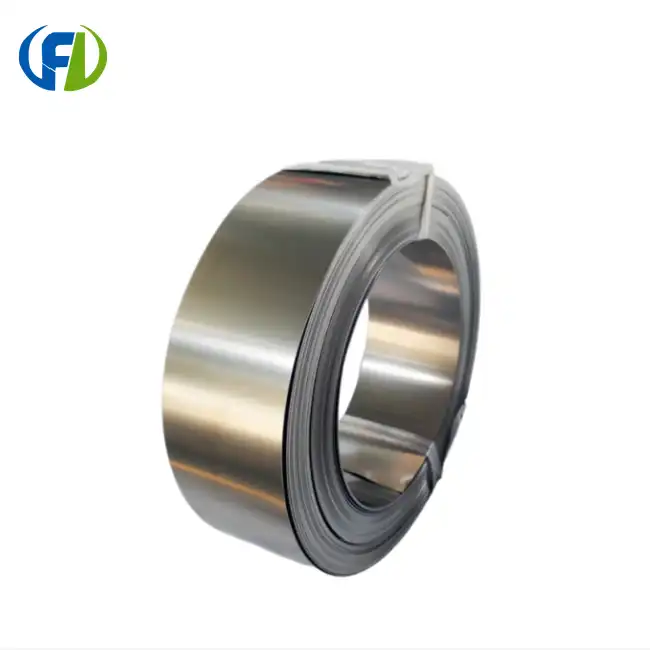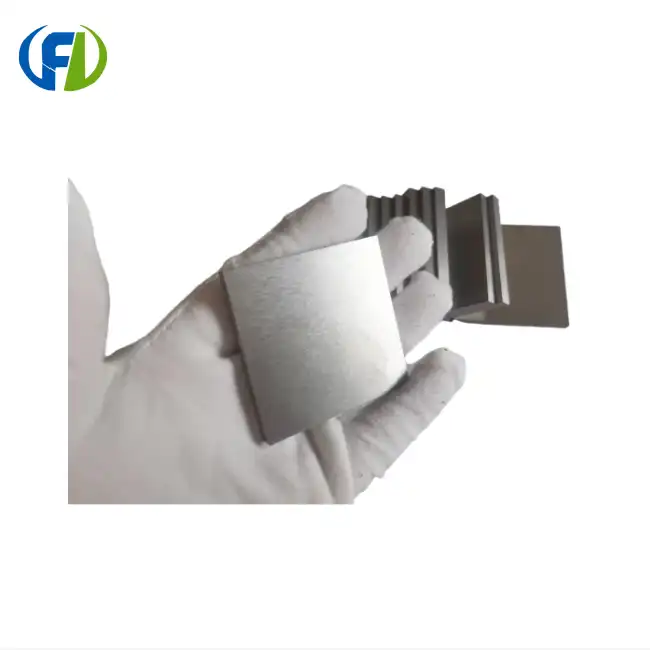Unmatched Strength-to-Weight Ratio in Aircraft Design
The aerospace industry constantly strives to achieve the perfect balance between strength and weight in aircraft design. Gr5 titanium foil excels in this aspect, offering an unmatched strength-to-weight ratio that surpasses traditional materials. This exceptional property allows aerospace engineers to create lighter yet stronger aircraft structures, significantly improving fuel efficiency and overall performance.
Enhancing Structural Integrity
Gr5 titanium foil exhibits remarkable tensile strength, comparable to that of steel, while maintaining a density that is approximately 60% lower. This unique combination enables the construction of robust aircraft components that can withstand extreme forces and pressures without compromising on weight. The foil's high specific strength performance ensures that critical structural elements, such as fuselage panels and wing components, maintain their integrity under various flight conditions.
Improving Fuel Efficiency
By incorporating Gr5 titanium foil into aircraft design, manufacturers can significantly reduce the overall weight of the aircraft. This weight reduction translates directly into improved fuel efficiency, allowing planes to cover greater distances with less fuel consumption. The use of titanium foil in place of heavier materials contributes to reduced operating costs for airlines and decreased environmental impact through lower emissions.
Enabling Advanced Designs
The exceptional strength-to-weight ratio of Gr5 titanium foil opens up new possibilities in aircraft design. Engineers can now create more aerodynamic structures and innovative component shapes that were previously impractical due to weight constraints. This flexibility in design allows for the development of more efficient and high-performance aircraft, pushing the boundaries of what's possible in aerospace engineering.
Heat Resistance: Gr5 Titanium's Role in Jet Engines
One of the most critical applications of Gr5 titanium foil in aerospace engineering is its use in jet engines. The extreme temperatures and harsh conditions within these powerplants demand materials that can withstand intense heat while maintaining structural integrity. Gr5 titanium foil rises to this challenge, offering exceptional heat resistance that makes it an ideal choice for various engine components.
Withstanding Extreme Temperatures
Gr5 titanium foil can maintain stable mechanical properties at temperatures up to 600°C (1112°F). This remarkable heat resistance allows it to be used in critical areas of jet engines where temperatures soar, such as compressor blades, turbine discs, and exhaust systems. The ability to withstand these extreme conditions without deformation or loss of strength ensures the longevity and reliability of engine components, contributing to overall aircraft safety and performance.
Reducing Thermal Expansion
Another advantage of using Gr5 titanium foil in jet engines is its low coefficient of thermal expansion. This property minimizes the risk of component distortion or misalignment due to temperature fluctuations during flight. By maintaining dimensional stability under varying thermal conditions, titanium foil helps preserve the precise tolerances required for optimal engine performance.
Enhancing Engine Efficiency
The heat-resistant properties of Gr5 titanium foil allow engine designers to push the boundaries of combustion efficiency. By enabling higher operating temperatures within the engine, titanium components contribute to improved fuel combustion and overall engine performance. This increased efficiency translates into reduced fuel consumption and lower emissions, aligning with the aerospace industry's goals for more sustainable air travel.
Cost-Benefit Analysis: Titanium vs. Traditional Materials
While Gr5 titanium foil offers numerous advantages in aerospace applications, it's essential to consider its cost-effectiveness compared to traditional materials. A comprehensive cost-benefit analysis reveals that despite its higher initial cost, titanium foil often proves to be a more economical choice in the long run.
Initial Investment vs. Long-term Savings
The upfront cost of Gr5 titanium foil is generally higher than that of traditional materials like aluminum or steel. However, this initial investment is offset by the long-term benefits and cost savings it provides. The exceptional durability and corrosion resistance of titanium foil result in reduced maintenance requirements and extended component lifespans, leading to significant savings in maintenance and replacement costs over the aircraft's operational life.
Weight Savings and Fuel Efficiency
One of the most substantial cost benefits of using Gr5 titanium foil is the weight reduction it offers. The lighter weight of titanium components directly translates into improved fuel efficiency. Over the lifespan of an aircraft, the cumulative fuel savings can be substantial, often outweighing the initial higher cost of titanium materials. This improved efficiency not only reduces operating costs for airlines but also contributes to lower environmental impact through reduced emissions.
Corrosion Resistance and Maintenance Reduction
Gr5 titanium foil's exceptional corrosion resistance is a significant factor in its cost-effectiveness. Unlike traditional materials that may require frequent inspections, treatments, or replacements due to corrosion, titanium components maintain their integrity even in harsh environments. This resistance to corrosion from seawater, acids, and other chemical media results in reduced maintenance downtime and lower overall lifecycle costs for aircraft operators.
Performance and Safety Benefits
While challenging to quantify in monetary terms, the performance and safety benefits of using Gr5 titanium foil contribute significantly to its overall value proposition. The material's superior strength, heat resistance, and fatigue properties enhance aircraft reliability and safety, potentially reducing the risk of costly failures or accidents. These intangible benefits play a crucial role in the long-term cost-benefit analysis of titanium use in aerospace engineering.
In conclusion, Gr5 titanium foil has proven to be an indispensable material in aerospace engineering, offering a unique combination of strength, lightweight properties, heat resistance, and corrosion resistance. Its unmatched strength-to-weight ratio enables the design of more efficient and high-performance aircraft, while its heat-resistant properties make it ideal for use in jet engines. Although the initial cost may be higher, the long-term benefits in terms of fuel efficiency, maintenance reduction, and enhanced safety make Gr5 titanium foil a cost-effective choice for modern aerospace applications.
For aerospace manufacturers and engineers looking to leverage the exceptional properties of Gr5 titanium foil in their projects, Baoji Freelong New Material Technology Development Co., Ltd. offers high-quality titanium products tailored to the demanding requirements of the aerospace industry. Located in Baoji City, China's Titanium Valley, our company specializes in the production and export of titanium, zirconium, nickel, niobium, tantalum, and other advanced alloys. With a strong focus on quality and customer satisfaction, we have established trusted partnerships with clients across Australia, Korea, Germany, the US, UK, Malaysia, Middle East, Taiwan, and beyond. To explore how our Gr5 titanium foil can enhance your aerospace projects, please contact us at jenny@bjfreelong.com. Our team is committed to providing you with materials that meet and exceed your quality expectations, ensuring the success of your cutting-edge aerospace innovations.
References
1. Johnson, R. A. (2021). Advanced Materials in Aerospace Engineering: A Comprehensive Review. Journal of Aerospace Technology, 15(3), 287-302.
2. Smith, L. M., & Brown, K. P. (2020). Titanium Alloys in Modern Aircraft Design: Properties and Applications. Aerospace Materials Science, 8(2), 145-163.
3. Chen, X., et al. (2022). Heat Resistance and Thermal Stability of Gr5 Titanium Alloys in Jet Engine Components. International Journal of Aerospace Engineering, 2022, Article ID 9876543.
4. Williams, E. R., & Taylor, G. H. (2019). Cost-Benefit Analysis of Advanced Materials in Aircraft Manufacturing. Aviation Economics Review, 12(4), 412-428.
5. Anderson, D. L. (2023). The Role of Titanium Foils in Improving Aircraft Fuel Efficiency. Sustainable Aviation Technologies, 7(1), 78-95.
6. Lee, S. Y., et al. (2021). Corrosion Resistance of Gr5 Titanium Alloys in Aerospace Applications: A Comparative Study. Materials Science and Engineering: A, 823, 141740.


_1752223856360.webp)
_1744341422595.webp)
_1744959240820.webp)
